|
Saltwater Crabs are a must have cleaner for any reef aquarium. But it's important to know what saltwater aquarium crabs are fine for reef tanks and which ones would be reef destroyers. Happily for reef aquarist's there are a number of saltwater crabs that are the perfect reef tank janitors to keep problems like hair algae, bubble algae, cyano bacteria, and excess food (detritus) all under control.
|
Red Scarlet Reef Hermit Crab
Paguristes cadenati
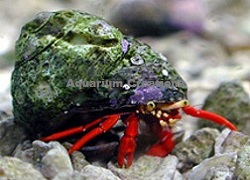
Scarlet Crabs have an appetite for detritus, filamentous, hair, and slime algae, as well as cyanobacteria.
Description:
Scarlet Hermit Crabs are very hardy
and requires minimal care in a well-established system. They
have a voracious appetite for detritus and are particularly fond
of filamentous, hair, and slime algae, as well as the dreaded
cyanobacteria. Also, unlike some hermit crabs, Scarlet Reef Hermit
Crabs are very peaceful towards their tankmates. Native to the
reef faces and coral rubble of the Caribbean, these active scavengers
can consume large amounts of animal matter and algae. The Scarlet
Reef Crab will only grow to an adult size of 1-1/2" in length.
Diet and Feeding:
Besides keeping your tank immaculate while it feeds, if algae levels are insufficient supplement their diet with dried seaweed called Nori, algae pellets, or algae waffers. As with all invertebrates, they do not tolerate copper-based medications and extreme fluctuations in water parameters.
Reef Compatability:
Excellent will not harm inverts or corals
Level of Care:
Easy
Approximate Purchase Size:
1/2"
|
Pack of 1 $7.95
Pack of 5 $35.00
Pack of 10 $70.00
Pack of 25 $145.00
Pack of 50 $195.00
Pack of 100 $390.00
|
Pom Pom Crab
Lybia tessellata
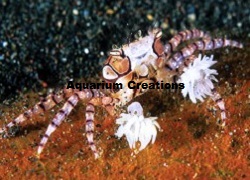
Description:
The Indo-Pacfic native Pom Pom Crab is a comical aquarium addition. This unique crab species carries a small anemone, which look like pom poms, in each claw. There are at least two purposes for carrying the anemones. The first is a simple matter of defense. The Pom Pom will taunt would-be predators by shaking the anemones in hopes of stinging the invader into retreat. It also mops the substrate to gather uneaten food, thus creating a symbiotic relationship between the Pom Pom Crab and its pom poms. The anemone undoubtedly benefits by getting to eat its share of the treasure. Also known as the Boxer Crab, it is a hardy creature that grows to about an inch in length. Because of this small size, it is great for the mini-reef aquarium. This crab is attractively marked, with striped legs and bold markings. The anemones are dropped during molting but are retrieved once this process completes. Curiously, lab studies have shown that a crab that loses one anemone will attempt to split the one it has into two regenerated clones, a method used by humans to propagate larger anemones. They may be kept in groups and females will produce reddish colored egg masses that they carry on their abdomens.
Diet and Feeding:
The diet of the Pom Pom Crab should include meaty foods such as mysis shrimp, chopped fish and clams. As with all invertebrates, they do not tolerate copper-based medications and extreme fluctuations in water parameters.
Reef Compatability:
Excellent will not harm inverts or corals
Level of Care:
Easy
Approximate Purchase Size:
1/2" to 1"
|
Price Each $29.99
|
Dwarf Blue Leg Reef Hermit Crab
Clibanarius tricolor
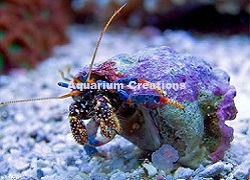
Description:
Dwarf Blue Leg hermit crabs are one of the most popular scavengers in the aquarium trade. Known for their small size, and excellent reef combatibility, this omnivore is able to reach tight crevices and polish off the detritus and algae that bigger inverts cannot get to. They will scour the sand and live rock in search of food and leave the tank virtually nitrate-free. They make excellent tank cleaners and a great addition to your clean-up crew. They have bright blue striped legs with orange antennas.
Diet and Feeding:
Besides keeping your tank immaculate while it feeds, if algae levels are insufficient supplement their diet with dried seaweed called Nori, algae pellets, or algae waffers. As with all invertebrates, they do not tolerate copper-based medications and extreme fluctuations in water parameters.
Reef Compatability:
Excellent will not harm inverts or corals
Level of Care:
Easy
Approximate Purchase Size:
1/4" to 3/4"
|
Price Each $1.95
Pack of 12 $19.95
Pack of 25 $39.95
Pack of 50 $78.95
Pack of 100 $149.95
|
Dwarf Red Leg Reef Hermit Crab
Chibanarius digueti

Very effective at elliminating hair algae and other nuisance algaes.
Description:
The Dwarf Red Leg Reef Hermit Crab is a voracious scavenger. Like its Blue Leg cousin, the Dwarf Red Leg Reef Hermit Crab serves as an ideal member of your marine or reef aquarium's cleanup crew. Also known simply as the Red Tip Hermit Crab, totally Reef safe, this omnivore will scavenge all over your live rock and sand substrate - finding its way into the tightest of spaces - to feed on algae and detritus.
Diet and Feeding:
The Dwarf Red Leg Reef Hermit Crab is best kept in a reef-style aquarium where it will have ample supplies of algae to eat. If there is insufficient algae to eat, their diet must be supplemented with dried seaweed.
Reef Compatability:
Excellent will not harm inverts or corals
Level of Care:
Easy
Approximate Purchase Size:
1/2" to 1"
|
Price Each $2.95
Pack of 5 $14.95
Pack of 10 $27.95
Pack of 15 $39.95
Pack of 20 $51.95
Pack of 25 $63.95
Pack of 50 $117.95
Pack of 100 $219.95
Pack of 250 $498.95
|
Emerald Crab
Mithrax Sculptus
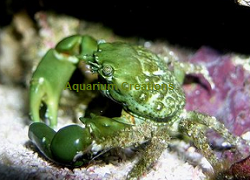
Excellent Algae Eater including troublesome Bubble Algae
Description:
Green Emerald Crabs are reef-safe algae eaters and an excellent addition to your cleaner crew. They are one of the few inverts that will eat nuisance bubble algae which makes them very popular among reef keepers. It will also feed on uneaten meaty foods and many of the types of nuisance algae found in reef aquariums. Its distinct, flat shiny green body and hairy legs easily identify the Emerald Mithrax Crab. They have dull tipped claws that they use to pick various types of algae from the rockwork. Native to the reefs of the Caribbean, the Emerald Mithrax Crab is nocturnal and hide in caves and amongst rock and coral during the day. In the home aquarium, it requires a well-established aquarium with plenty of rockwork and hiding places.
Diet and Feeding:
Care needs to be taken to ensure an ample supply of food is available for the Emerald Mithrax Crab. Many supplement their diet with dried seaweed and chopped meaty foods, such as shrimp, and/or a quality pellet fish food. Like other invertebrates, the Emerald Mithrax does not tolerate copper-based medications or fluctuating water parameters.
Reef Compatability:
Excellent will not harm inverts or corals
Level of Care:
Easy
Approximate Purchase Size:
1"
|
Price Each $8.50
Pack of 3 $24.50/B>
Pack of 6 $49.50
Pack of 12 $89.50
Pack of 25 $179.50
|
Horseshoe Crab
Limulus polyphemus
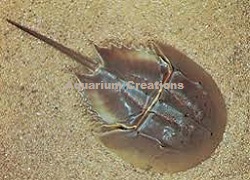
Sand Stirer , Detritus Eater
Description:
Ancestors of horseshoe crabs date back over 450 million years--long before the age of the dinosaurs. The Horseshoe Crab is very strange in appearance and can be unique specimens for any aquarium. Very hardy , they can be a good choice for beginners. Horseshoe Crabs are bottom dwellers, and in the wild usually burrow in mud or sand flats in tidal areas or estuaries. The Horseshoe Crab is greenish brown to light tan in color. The dorsal part of the body is rounded, and it has a long spike for a tail. The Horseshoe Crab is really not a crab, but more closely related to spiders and mites, belonging to a group of animals called chelicerates. Horseshoe Crabs can grow quite large. The female horseshoe crabs usually grow larger than the males, with their body reaching a maximum size of 12 inches in diameter. When small, they are very efficient scavengers and are great for aerating and maintaining sand beds. In the aquarium, your Horseshoe Crab will not grow that large, and will generally do best in a sandy substrate. They are very helpful in cleaning an aquarium through sifting through sand and gravel in search of worms and any organic debris. It will move the substrate around almost nonstop in its search for food. The Horseshoe Crab will move about, scavengiong detritus or other materials that have fallen to the bottom. Although it may find some food scavenging,
Diet and Feeding:
its diet should be supplemented with meaty items such as pieces of squid and shrimp.
Reef Compatability:
Excellent will not harm inverts or corals
Level of Care:
Easy
Approximate Purchase Size:
Small 1" to 2" Medium 2" to 3" Large: 3" to 4"
|
Small $17.99
Medium $19.99
Large $24.99
|
|

